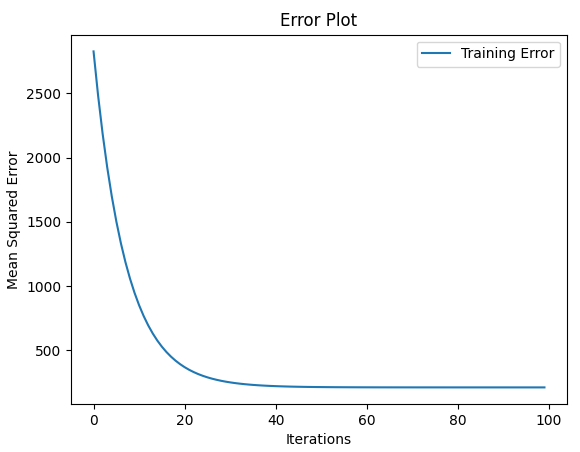python实现线性回归之简单回归
代码来源:https://github.com/eriklindernoren/ML-From-Scratch
首先定义一个基本的回归类,作为各种回归方法的基类:
- class Regression(object):
- """ Base regression model. Models the relationship between a scalar dependent variable y and the independent
- variables X.
- Parameters:
- -----------
- n_iterations: float
- The number of training iterations the algorithm will tune the weights for.
- learning_rate: float
- The step length that will be used when updating the weights.
- """
- def __init__(self, n_iterations, learning_rate):
- self.n_iterations = n_iterations
- self.learning_rate = learning_rate
- def initialize_wights(self, n_features):
- """ Initialize weights randomly [-1/N, 1/N] """
- limit = 1 / math.sqrt(n_features)
- self.w = np.random.uniform(-limit, limit, (n_features, ))
- def fit(self, X, y):
- # Insert constant ones for bias weights
- X = np.insert(X, 0, 1, axis=1)
- self.training_errors = []
- self.initialize_weights(n_features=X.shape[1])
- # Do gradient descent for n_iterations
- for i in range(self.n_iterations):
- y_pred = X.dot(self.w)
- # Calculate l2 loss
- mse = np.mean(0.5 * (y - y_pred)**2 + self.regularization(self.w))
- self.training_errors.append(mse)
- # Gradient of l2 loss w.r.t w
- grad_w = -(y - y_pred).dot(X) + self.regularization.grad(self.w)
- # Update the weights
- self.w -= self.learning_rate * grad_w
- def predict(self, X):
- # Insert constant ones for bias weights
- X = np.insert(X, 0, 1, axis=1)
- y_pred = X.dot(self.w)
- return y_pred
说明:初始化时传入两个参数,一个是迭代次数,另一个是学习率。initialize_weights()用于初始化权重。fit()用于训练。需要注意的是,对于原始的输入X,需要将其最前面添加一项为偏置项。predict()用于输出预测值。
接下来是简单线性回归,继承上面的基类:
- class LinearRegression(Regression):
- """Linear model.
- Parameters:
- -----------
- n_iterations: float
- The number of training iterations the algorithm will tune the weights for.
- learning_rate: float
- The step length that will be used when updating the weights.
- gradient_descent: boolean
- True or false depending if gradient descent should be used when training. If
- false then we use batch optimization by least squares.
- """
- def __init__(self, n_iterations=100, learning_rate=0.001, gradient_descent=True):
- self.gradient_descent = gradient_descent
- # No regularization
- self.regularization = lambda x: 0
- self.regularization.grad = lambda x: 0
- super(LinearRegression, self).__init__(n_iterations=n_iterations,
- learning_rate=learning_rate)
- def fit(self, X, y):
- # If not gradient descent => Least squares approximation of w
- if not self.gradient_descent:
- # Insert constant ones for bias weights
- X = np.insert(X, 0, 1, axis=1)
- # Calculate weights by least squares (using Moore-Penrose pseudoinverse)
- U, S, V = np.linalg.svd(X.T.dot(X))
- S = np.diag(S)
- X_sq_reg_inv = V.dot(np.linalg.pinv(S)).dot(U.T)
- self.w = X_sq_reg_inv.dot(X.T).dot(y)
- else:
- super(LinearRegression, self).fit(X, y)
这里使用两种方式进行计算。如果规定gradient_descent=True,那么使用随机梯度下降算法进行训练,否则使用标准方程法进行训练。
最后是使用:
- import numpy as np
- import pandas as pd
- import matplotlib.pyplot as plt
- from sklearn.datasets import make_regression
- import sys
- sys.path.append("/content/drive/My Drive/learn/ML-From-Scratch/")
- from mlfromscratch.utils import train_test_split, polynomial_features
- from mlfromscratch.utils import mean_squared_error, Plot
- from mlfromscratch.supervised_learning import LinearRegression
- def main():
- X, y = make_regression(n_samples=100, n_features=1, noise=20)
- X_train, X_test, y_train, y_test = train_test_split(X, y, test_size=0.4)
- n_samples, n_features = np.shape(X)
- model = LinearRegression(n_iterations=100)
- model.fit(X_train, y_train)
- # Training error plot
- n = len(model.training_errors)
- training, = plt.plot(range(n), model.training_errors, label="Training Error")
- plt.legend(handles=[training])
- plt.title("Error Plot")
- plt.ylabel('Mean Squared Error')
- plt.xlabel('Iterations')
- plt.savefig("test1.png")
- plt.show()
- y_pred = model.predict(X_test)
- mse = mean_squared_error(y_test, y_pred)
- print ("Mean squared error: %s" % (mse))
- y_pred_line = model.predict(X)
- # Color map
- cmap = plt.get_cmap('viridis')
- # Plot the results
- m1 = plt.scatter(366 * X_train, y_train, color=cmap(0.9), s=10)
- m2 = plt.scatter(366 * X_test, y_test, color=cmap(0.5), s=10)
- plt.plot(366 * X, y_pred_line, color='black', linewidth=2, label="Prediction")
- plt.suptitle("Linear Regression")
- plt.title("MSE: %.2f" % mse, fontsize=10)
- plt.xlabel('Day')
- plt.ylabel('Temperature in Celcius')
- plt.legend((m1, m2), ("Training data", "Test data"), loc='lower right')
- plt.savefig("test2.png")
- plt.show()
- if __name__ == "__main__":
- main()
利用sklearn库生成线性回归数据,然后将其拆分为训练集和测试集。
utils下的mean_squared_error():
- def mean_squared_error(y_true, y_pred):
- """ Returns the mean squared error between y_true and y_pred """
- mse = np.mean(np.power(y_true - y_pred, 2))
- return mse
结果:

Mean squared error: 532.3321383700828

python实现线性回归之简单回归的更多相关文章
- 机器学习经典算法具体解释及Python实现--线性回归(Linear Regression)算法
(一)认识回归 回归是统计学中最有力的工具之中的一个. 机器学习监督学习算法分为分类算法和回归算法两种,事实上就是依据类别标签分布类型为离散型.连续性而定义的. 顾名思义.分类算法用于离散型分布预測, ...
- python实现线性回归
参考:<机器学习实战>- Machine Learning in Action 一. 必备的包 一般而言,这几个包是比较常见的: • matplotlib,用于绘图 • numpy,数组处 ...
- python求线性回归斜率
一. 先说我对这个题目的理解 直线的x,y方程是这样的:y = kx+b, k就是斜率. 求线性回归斜率, 就是说 有这么一组(x, y)的对应值——样本.如果有四组,就说样本量是4.根据这些样本,做 ...
- 吴裕雄 python 机器学习——线性回归模型
import numpy as np from sklearn import datasets,linear_model from sklearn.model_selection import tra ...
- python模拟线性回归的点
构造符合线性回归的数据点 import numpy as np import tensorflow as tf import matplotlib.pyplot as plt # 随机生成1000个点 ...
- python机器学习---线性回归案例和KNN机器学习案例
散点图和KNN预测 一丶案例引入 # 城市气候与海洋的关系研究 # 导包 import numpy as np import pandas as pd from pandas import Serie ...
- Python机器学习/LinearRegression(线性回归模型)(附源码)
LinearRegression(线性回归) 2019-02-20 20:25:47 1.线性回归简介 线性回归定义: 百科中解释 我个人的理解就是:线性回归算法就是一个使用线性函数作为模型框架($ ...
- 机器学习之线性回归(纯python实现)][转]
本文转载自:https://juejin.im/post/5a924df16fb9a0634514d6e1 机器学习之线性回归(纯python实现) 线性回归是机器学习中最基本的一个算法,大部分算法都 ...
- 【机器学习】线性回归python实现
线性回归原理介绍 线性回归python实现 线性回归sklearn实现 这里使用python实现线性回归,没有使用sklearn等机器学习框架,目的是帮助理解算法的原理. 写了三个例子,分别是单变量的 ...
随机推荐
- iOS 真机查看沙盒目录
iExplorer 的方法试的时候设备都无法检测到,建议放弃 启用iTunes文件共享,才能够看沙盒内的文件,只需要在plist文件中添加如下信息: <key>UIFileSharingE ...
- spring boot 装载自定义yml文件
yml格式的配置文件感觉很人性化,所以想把项目中的.properties都替换成.yml文件,蛋疼的是springboot自1.5以后就把@configurationProperties中的locat ...
- python 开发工具简介
一.python 开发工具简介 1.IDLE IDLE是开发python程序的基本IDE(集成开发环境),具备基本的IDE的功能,是非商业Python开发的不错的选择.当安装好python以后,IDL ...
- 运行npm安装wepy2踩坑error EEXIST 问题
windows 10安装wepy2 以前用过wepy1,现在要学习wepy2,运行以下命令出错 npm install @wepy/cli -g # 全局安装 WePY CLI 工具 打开log文件, ...
- IntelliJ IDEA 激活码 [已购买,分享给码友]
一.前言 笔者在网上找了一圈,各种方法都试过了,之前那种在网上随便找个注册码,过了一段时间就被封了,想了想还是经常用的和朋友一起购买了,方便日后使用 二.下载最新的 IDEA 其实也可以从老版本直接升 ...
- stm32:简单按键输入实现
开发环境keil4,芯片STM32F103C8T6 1.main.c //串口实验 #include "sys.h" #include "delay.h" #i ...
- Go语言笔记 (2) 变量命名与多重赋值
变量命名 1.大小写 观摩以下代码: func main() { var m int = "你" var M int = "我" fmt.Println(m,M ...
- 搭建mariadb数据库系统《一》
搭建mariadb数据库系统 案例3:搭建mariadb数据库系统 3 ...
- hacknos-player靶机渗透
靶机下载地址https://www.vulnhub.com/entry/hacknos-player,459/ 网络配置 该靶机可能会存在无法自动分配IP的情况,所以无法扫描到的情况下需要手动配置获取 ...
- android注册验证码的使用
主要是创建了验证码的生成类. 通过此生成类,与imageview相互联系起来,实现验证码显示.并添加点击事件,实现验证码的切换. 实验的截图如下:(验证码可以点击切换) 具体的关于验证码的生成类如下: ...
